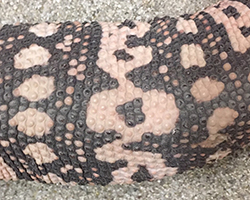Gila Coloration

When you spot a Gila monster in the wild, they are usually already pretty near to you. Then, the first thing you probably notice is their orange and black coloration. When they were far away, those colors helped them blend into the desert background, making them difficult to see. This is especially true if they are under a bush or tree, with bits of light and shade. But up close, their colors act as a warning to predators, letting them know that they are venomous and can defend themselves.
Such bright and dark colors (especially in stripes or repeating patterns) sometimes serve as warning coloration, or aposematic coloration. Some researchers even think that juveniles have brighter colors and have colors in a more striped pattern, to act as a stronger warning to predators. And if the predators don’t listen, they may end up with a painful bite, whether from an adult or a baby Gila monster.
Additional images via Wikimedia Commons. Poison dart frog image by V2.
Read more about: Hardy Gilas
Bibliographic details:
- Article: Gila Monster Coloration
- Author(s): Dr. Biology
- Publisher: Arizona State University School of Life Sciences Ask A Biologist
- Site name: ASU - Ask A Biologist
- Date published:
- Date accessed:
- Link: https://askabiologist.asu.edu/gila-monster-colors
APA Style
Dr. Biology. (). Gila Monster Coloration. ASU - Ask A Biologist. Retrieved from https://askabiologist.asu.edu/gila-monster-colors
Chicago Manual of Style
Dr. Biology. "Gila Monster Coloration". ASU - Ask A Biologist. . https://askabiologist.asu.edu/gila-monster-colors
Dr. Biology. "Gila Monster Coloration". ASU - Ask A Biologist. . ASU - Ask A Biologist, Web. https://askabiologist.asu.edu/gila-monster-colors
MLA 2017 Style

Be Part of
Ask A Biologist
By volunteering, or simply sending us feedback on the site. Scientists, teachers, writers, illustrators, and translators are all important to the program. If you are interested in helping with the website we have a Volunteers page to get the process started.

